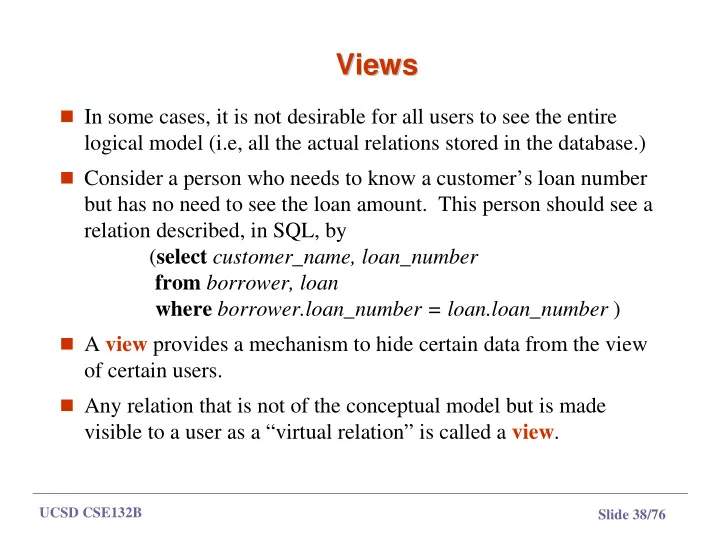

Views Views � In some cases, it is not desirable for all users to see the entire logical model (i.e, all the actual relations stored in the database.) � Consider a person who needs to know a customer’s loan number but has no need to see the loan amount. This person should see a relation described, in SQL, by ( select customer_name, loan_number from borrower, loan where borrower.loan_number = loan.loan_number ) � A view provides a mechanism to hide certain data from the view of certain users. � Any relation that is not of the conceptual model but is made visible to a user as a “virtual relation” is called a view . UCSD CSE132B Slide 38/76
View Definition View Definition � A view is defined using the create view statement which has the form create view v as < query expression > where <query expression> is any legal SQL expression. The view name is represented by v. � Once a view is defined, the view name can be used to refer to the virtual relation that the view generates. � View definition is not the same as creating a new relation by evaluating the query expression � Rather, a view definition causes the saving of an expression; the expression is substituted into queries using the view. UCSD CSE132B Slide 39/76
Views in SQL Views in SQL � A view is a “virtual” table that is derived from other tables � Allows for limited update operations (since the table may not physically be stored) � Allows full query operations � A convenience for expressing certain operations UCSD CSE132B Slide 40/76
Specification of Views Specification of Views � SQL command: CREATE VIEW � a table (view) name � a possible list of attribute names (for example, when arithmetic operations are specified or when we want the names to be different from the attributes in the base relations) � a query to specify the table contents UCSD CSE132B Slide 41/76
Example Queries Example Queries � A view consisting of branches and their customers create view all_customer as ( select branch_name, customer_name from depositor, account where depositor.account_number = account.account_number ) union ( select branch_name, customer_name from borrower, loan where borrower.loan_number = loan.loan_number ) � Find all customers of the Perryridge branch select customer_name from all_customer where branch_name = ‘Perryridge’ UCSD CSE132B Slide 42/76
Views Defined Using Other Views Views Defined Using Other Views � One view may be used in the expression defining another view � A view relation v 1 is said to depend directly on a view relation v 2 if v 2 is used in the expression defining v 1 � A view relation v 1 is said to depend on view relation v 2 if either v 1 depends directly to v 2 or there is a path of dependencies from v 1 to v 2 � A view relation v is said to be recursive if it depends on itself. UCSD CSE132B Slide 43/76
SQL Views: Another Example SQL Views: Another Example � Specify a different WORKS_ON table CREATE TABLE WORKS_ON_NEW AS SELECT FNAME, LNAME, PNAME, HOURS FROM EMPLOYEE, PROJECT, WORKS_ON WHERE SSN=ESSN AND PNO=PNUMBER GROUP BY PNAME; UCSD CSE132B Slide 44/76
Using a Virtual Table Using a Virtual Table � We can specify SQL queries on a newly create view: SELECT FNAME, LNAME FROM WORKS_ON_NEW WHERE PNAME=‘Seena’; � When no longer needed, a view can be dropped: DROP WORKS_ON_NEW; UCSD CSE132B Slide 45/76
Efficient View Implementation Efficient View Implementation � Query modification: present the view query in terms of a query on the underlying base tables � disadvantage: inefficient for views defined via complex queries (especially if additional queries are to be applied to the view within a short time period) UCSD CSE132B Slide 46/76
Efficient View Implementation Efficient View Implementation � View materialization: involves physically creating and keeping a temporary table � assumption: other queries on the view will follow � concerns: maintaining correspondence between the base table and the view when the base table is updated � strategy: incremental update UCSD CSE132B Slide 47/76
Update of a View Update of a View � Create a view of all loan data in the loan relation, hiding the amount attribute create view branch_loan as select branch_name, loan_number from loan � Add a new tuple to branch_loan insert into branch_loan values (‘Perryridge’, ‘L-307’) This insertion must be represented by the insertion of the tuple (‘L-307’, ‘Perryridge’, null ) into the loan relation UCSD CSE132B Slide 48/76
View Update View Update � Update on a single view without aggregate operations: update may map to an update on the underlying base table � Views involving joins: an update may map to an update on the underlying base relations � not always possible UCSD CSE132B Slide 49/76
Updates Through Views (Cont.) Updates Through Views (Cont.) � Some updates through views are impossible to translate into updates on the database relations � create view v as select branch_name from account insert into v values (‘ L-99’, ‘ Downtown’ , ‘23’ ) � Others cannot be translated uniquely � insert into all_customer values (‘ Perryridge’ , ‘ John ’) � Have to choose loan or account, and create a new loan/account number! � Most SQL implementations allow updates only on simple views (without aggregates) defined on a single relation UCSD CSE132B Slide 50/76
Un- -updatable Views updatable Views Un � Views defined using groups and aggregate functions are not updateable � Views defined on multiple tables using joins are generally not updateable � WITH CHECK OPTION : must be added to the definition of a view if the view is to be updated � to allow check for updatability and to plan for an execution strategy UCSD CSE132B Slide 51/76
Recommend
More recommend